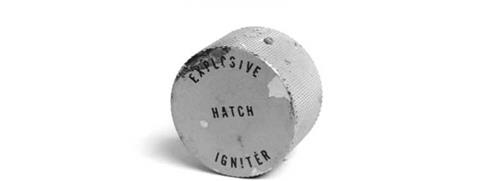FINDING A LOST SPACECRAFT
On the evening of Wednesday, 20 July 1999, Liberty Bell 7 was finally recovered from the depths of the Atlantic, just one day short of the 38th anniversary of Gus Grissom’s suborbital MR-4 mission, and 30 years to the day that Neil Armstrong and Buzz Aldrin had walked on the Moon.
It took eight hours to bring the spacecraft to the surface. “I actually designed the recovery tools used to create a new lift point on the capsule as the old Dacron loop was judged not suitable,” Newport explained. “This was done while I was working at Oceaneering Space Systems and the dimensions were checked using the MA-1 wreckage that Max [Ary] had at the Cosmosphere (in 1993). After finding the capsule and before the second trip, I took one of the tools to NASM’s Garber facility and established where we could and could not attach them on the escape tower mounting ring. You just couldn’t place them anywhere, as fasteners and sensors interfered in certain areas. I used the images I took while the tools were being installed during the recovery to make sure they were being put where they should be. Oceaneering had earlier misplaced three of the four tools but I had one of them in my bedroom closet for years, always hoping that I’d get a chance to use it.”17
Lifting Liberty Bell 7 was a delicate operation. The water-filled craft weighed 3,000 pounds as it was slowly raised to the surface, so even using a super-strong Kevlar line everyone proceeded with the utmost of caution. To the former Hunt Club 1 helicopter pilot Jim Lewis’s amazement, when Liberty Bell 7 finally broke to the surface he saw that the recovery line which his co-pilot John Reinhard had attached in 1961 was still dangling from the top of the capsule. As he commented later, “To see it come out of the water again, like it did that long ago, was a feeling that I don’t have an adjective to apply to.” 18
Once the spacecraft had been successfully raised and anchored onto the deck of the ship, the two bomb experts carefully rummaged around the capsule’s interior and removed the explosive SOFAR device, which they threw overboard.
Considering the time that the capsule had spent in the murky depths, it was in surprisingly good condition as Newport noted, although the beryllium heat shield had totally disintegrated. “I can still see the actual straps that Grissom wore during his flight,” he reported during a phone call from the ship. “The personal parachute inside the spacecraft is perfectly intact.” But things made of aluminum, such as the control panels, had deteriorated badly.19
Newport would later write: “While Liberty Bell 7’s condition was indeed remarkable, the interior was a mess. The forward hatch had come loose from its mount and was lodged in the explosive hatch opening. I gingerly extracted it from the capsule and finally had my first look at the interior. Water continued to drip all through the inside as I stuck my head in, seeing that part of the once intact control panel had disintegrated, leaving numerous flight instruments dangling like apples on a tree. But what struck me most was the smell… It was like the odor of carbon or decayed wood, probably from the chemical action of the electrolyte in the craft’s batteries. The optical periscope had broken in half and was now laying amongst other rubble such as the decomposed remains of the control panel and what was left of the astronaut camera. I could see part of one of the film spools lying exposed, which eliminated any hope of saving the film.”20
When asked if they had also managed to locate the spacecraft’s hatch, Newport responded that due to a two-day delay caused by problems with the navigational data they had no time to search for the hatch, and the important thing now was to get the spacecraft to port as soon as possible. Once there the Kansas Cosmosphere and Space Center people would transport Liberty Bell 7 to Hutchinson, Kansas, where their experts would disassemble and clean the capsule.
It was thought possible that the lingering mystery of why the hatch blew might have been recorded in the cockpit film camera that was running as Liberty Bell 7 splashed down, but as Newport had discovered the camera had broken open and the film was completely ruined. “I don’t think there’s going to be any way to answer that question, ever,” Newport said at the time. He added that he had no intentions of going back to look for the hatch, ever. “Finding the spacecraft was good enough.”21
Time would change Newport’s opinion on recovering the hatch. “Well, they say never say never, and I don’t remember exactly what I said regarding the hatch.
|
One item later recovered from within Liberty Bell 7 was the explosive hatch igniter knob. (Photo: Kansas Cosmosphere and Space Center) |
But I now think it can be found and is worth recovering. It was always in the plan to look for the hatch and I already had three targets worth investigating. At this point, I’m looking for money and equipment to go back to the site.”22











